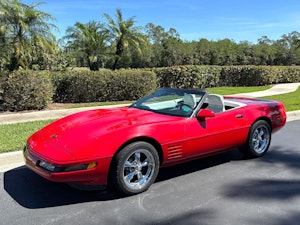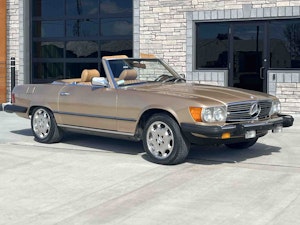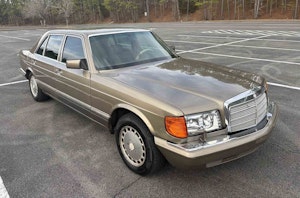Media | Articles
Why I Dislike Sunroofs (Part I)
In perusing car ads, you’ll sometimes see the term “slicktop,” which means that the car has no sunroof. While I loathe the car-salesman-vibe of the term almost as much as “restomod” or the phrase “all the hard work’s been done,” it’s gained traction because it accurately conveys the lack of an option as a positive. That is, if you say “no sunroof,” it makes it sound like the car is missing something that it should (or at least could) have, but in the opinion of many including myself, the opposite is true—the lack of a sunroof is actually plus.
Sunroofs are a pain. Most of them are rarely used, but that doesn’t prevent them from having or causing problems, and when they do, the hassle far outweighs their occasional sun-on-the-face benefit. While I don’t hate sunroofs the way I hate, say, decent rust-free cars that have been drift-modded, they can be more trouble than they’re worth. Here’s why.
The history of the modern sliding sunroof extends further back than I expected. Surprisingly, it appears to have begun a hundred years ago in a country not known for sunshine or fair weather—England. Richard Oliver Mobbs of London patented his sliding roof panel in Great Britain in 1925 and formed The Pytchley Autocar Company to build and sell it, with Morris and Austin adopting and incorporating the design in 1932. Pytchley, unfortunately, appears to have been one of the many casualties of World War II. Cadillac, Oldsmobile, Buick, and LaSalle apparently also offered a similar sliding roof panel just before the war. Like the Pytchley roof, their design also died on the vine.

The sunroof as we know it really took wing in the 1960s. The German manufacturer Golde produced both fabric and metal sliding sunroofs that became available on several German marques. It’s perhaps appropriate that “The People’s Car”—the VW Beetle—may have largely introduced the sunroof to the American public. Beetles were available with roll-back fabric sunroofs as far back as 1950, but a hand-cranked metal roof became an option in 1963. The first American car with a factory sliding sunroof was the 1960 Thunderbird with an available Golde roof. Unfortunately, there was no cranking mechanism; it needed to be slid by hand. And it was expensive. It was only available for a year. But in the late 1960s, the sunroof came back to Detroit, with the American Sunroof Company (ASC) supplying power sliding metal sunroofs to Ford for installation in Cougars and Thunderbirds.
In the mid-1970s, a confluence of fuel cost, emissions, and safety factors essentially killed off the production of convertibles in the United States for about a decade, leaving sunroofs and T-tops as the available options for those who wanted to see some sky while driving. In my humble opinion, neither of these comes close to giving you that wonderful whole-body-relaxation response of driving a fully-open car (Porche’s Targa top is a bit better), but the huge manufacturing advantage of the sunroof is that it maintains the car’s basic stiffening structure of a roof supported by pillars—the A and C-pillars at the front and rear, and the B-pillar behind the front door. As much as I love convertibles, with their roof and pillars gone, the body of the car needs to be further stiffened to compensate for the lack of a roof. My ‘99 BMW Z3 roadster feels very solid, but on older ‘verts, you still get a lot of body twist. I used to own a 1984 Alfa Spider, and it was so flexy that if I put the nose on ramps, I couldn’t open the doors.
Marketplace
Buy and sell classics with confidence
Sliding sunroofs, and their cousins, tilting but non-sliding glass moonroofs, remain popular and are standard equipment on many higher-end vehicles. But here’s the problem with sunroofs: They all leak. They’re designed to leak. Or, rather, they’re designed to deal with the fact that they leak. The sunroof seal is mainly there to reduce wind noise. Water is expected to get past it. Don’t believe me? Every sunroof in every car sold today and likely sold for the last 50 years has a four-sided moat beneath it with drain ports at the corners. The front two corners drain into rubber or plastic hoses that go down the A-pillars, the rear ones out the C-pillars. On many vintage cars, manufacturers didn’t take into account the fact that these cars would still be loved and driven half a century later. On my beloved 1970s BMW 2002s, the front sunroof drain hose protrudes through the inside corner of the wheel well. So far so good, but the rear one stops short and dumps water into the inside corner of the wheel well and the rocker, invariably rotting it out from the inside.

And things can go wrong with the “moat” system. A few months ago I wrote that my 2008 Nissan Armada was dripping water from the right side of the sunroof. It turned out that the drain hose had become detached from the right front drain spigot. I was thrilled that that was the problem, as the Armada forum had reports of the moat being cracked, which would’ve been much more difficult to repair.
That gets to the second issue: Sunroofs are complicated. In addition to drainage, the mechanism for sliding involves not just a pair of tracks but also cables and an electric or and-cranked winding mechanism to pull them. Plus, the sunroof not only moves back and forth but also up and down. Watch it closely sometime. When you open it, the back edge first drops down so it can retract beneath the surface of the roof, sort of like one tectonic plate subducting beneath another. It reverses this action when you close it. That means there’s a mechanism that not only slides it back and forth, but also manages that upward and downward motion of the back edge. If any of this breaks, the sunroof becomes very difficult to close. It’s little wonder that many folks in the vintage car world open the sunroof when they buy the car to make sure it works, then leave it shut.
And so, with that, I can tell you about the sunroof in the FrankenThirty (my 1988 BMW E30 325is that was apparently rebuilt with pieces of two different cars). When I bought the car, there was no seal on the sunroof at all, its left rear corner was sagging badly, and it would neither open nor close though I could hear the motor trying to turn. There was obvious staining on the rug indicating a history of water intrusion. I needed the car to sit outside while my wife and I were on vacation (in fact, unless I sell something, the car will likely need to sit outside all winter), so for the short term I simply taped the sunroof shut with packing tape.

To be clear, I would’ve left the sunroof taped shut, but a friend of mine shamed me into fixing it. My goal was not to rebuild the sunroof so I could hit the switch and slide it back and forth with alacrity and without fear. It was instead to get it closed, leave it closed, make sure it didn’t leak, and not spend a lot of money or time doing so. While the FrankenThirty has surprised me with its ready-to-run happy-to-be-part-of-the-family vibe, it’s still a somewhat ratty car, and I had zero desire to have a working sunroof be an isolated pocket of restored flawless functionality.
Although I couldn’t move the sunroof with its electric motor, there’s a little access panel that exposes the underside of its main gear, in the center of which is an Allen key hole that allows you to use a ratchet wrench and an Allen bit to hand-crank the sunroof. This enabled me to close it. I could then slide back the headliner trim panel and reach into the tracks, from which I pulled out several pieces of plastic that were jamming it, along with a section of rubber hose that I believe a previous owner had placed to hold up the sagging left rear corner. I eventually realized the plastic pieces were broken sections of the part of the mechanism that lifts up the back of the sunroof when you close it. (Remember what I said about it being complicated?)

To assess what was wrong and how to fix it, the sunroof panel had to come off. And since the car would be sitting roof-less for an indeterminate amount of time, it needed to come into the garage.
The panel is held to the winding mechanism by six Torx-head screws, but to see them, you first need to unsnap the front of the sunroof’s headliner piece, then slide it backward into the same recess where the sunroof panel itself slides. It actually wasn’t that bad to sit inside the car with my head up against the underside of the sunroof panel, wield a Torx bit on a swivel ratchet extension along with a flashlight to help get it into position, and unscrew all six.
With the panel off, I could look down on the broken plastic lifting section and see where the pieces went. I also could see that, since the sunroof had been partially open for years, there was all manner of detritus underneath—pine needles, pieces of acorns, evidence of mice, etc. I made sure there were no more broken pieces, vacuumed up all the flotsam, and lubricated the track with spray white lithium grease. I also ran a wire down and blew compressed air through the two front drains (the rear ones are basically unreachable).

It wasn’t clear to me how much I needed to remove in order to replace the broken plastic piece, and it was difficult to identify the part in BMW’s diagrams. Looking on eBay, I could see it sold as part of a sunroof cable assembly that was no longer available new, but for which $250 New Old Stock (NOS) pieces and $100-ish used items were available.

With nothing to lose, I decided to have a go at epoxying it back together with J-B PlasticWeld. Because the broken plastic section was right at the point where the rod for the lifting mechanism met it, I elected to reinforce the epoxy with a piece of metal. I cut a section off a small hose clamp, bent it into shape, carefully laid the pieces and the PlasticWeld into position, let it dry overnight, then tested that it worked without self-destructing.

I looked into buying a new sunroof seal, but the $125 cost for what’s basically a piece of weatherstripping put me off. I have a variety of sizes of high-quality adhesive-backed closed-cell foam tape I bought years ago from McMaster-Carr for sealing the door flaps on heater boxes. A ½-inch wide piece of 1/8-inch thick foam looked to be a good fit if I cut it lengthwise. I cut four small pieces, put one on each of the four edges of the sunroof, and test-fit it in the opening. And remember—as I said, this is mainly a wind noise seal. It seemed to be the right size, so I cut one long section of adhesive-backed foam seal, cleaned the outer edge of the sunroof, and laid it in place. I then test-fit the panel and seal. It was astonishing how well it fit.


With that, I carefully re-mounted the sunroof panel, leaving the Torx bolts slightly loose to fine-position it. I gently hand-cranked it into position, gritting my teeth as the rod on the end of the plastic mechanism pushed the back edge upward. I expected it to fail at any moment.
It didn’t. It held.
I carefully tightened the Torx bolts, smiled at my masterwork, and unplugged the sunroof switch so I wouldn’t be tempted to open it. I then moved the car out of the garage and parked it in the driveway.
That night, it rained. In the morning, I was greeted with water dripping from the headliner and puddles on the seat and floor.
Okay, maybe I do hate sunroofs.
(Next week, I divulge the multiple layers of what went wrong.]
***
Rob’s latest book, The Best Of The Hack Mechanic™: 35 years of hacks, kluges, and assorted automotive mayhem, is available on Amazon here. His other seven books are available here on Amazon, or you can order personally inscribed copies from Rob’s website, www.robsiegel.com.





















Often the killer of the sun roof is the car owner.
If you have one some minor care once a year will keep them operating well.
Clean the drains and lube the seals and tracks with silicone lube. If you park under trees clean the drains more. Most common breakage is the wind deflector on some and switch. I have had 4 sun roofs for over a collective 35 years. Only a latch on the sun shade broke and it was under warranty.
Same on T tops. Seal treatment is prime In fact you need to put the Convertible in that too as the seals are what keep water out. If treated regularly then they prevent issues outside some damage done to them. My T tops are 38 years old and no issues. My convertible has a new top and seal so I treated it as soon as I bought it.
This is just a maintenance item no different than paint care, leather seat care or even oil changes. When buying used you need to really check this out or buy a wet suit.
I used to love sunroofs, but the older I get, the less I care.
My w126 has sunroof issues. Which I largely fixed, but made the crucial error of re-assembling without greasing the slider rails. So now it jams after opening 1 inch.
So I have it in “weathertight” position, and it’ll stay that way until the motivation to fix it comes upon me. Maybe this winter when I’ve run out of other things to fix.
Man Rob, you said almost everything perfectly to me in the first two paragraphs. And, like Colton’s first sentence, I also used to think they were almost cool. In fact, I cut holes in a ’83 Toyota SR-5 pick-up once and installed pop-up tinted moonroofs (it was the ’80s folks, everyone was doing weird stuff, so cut me some slack, willya?). But as time went by, I grew disillusioned with the whole idea. In fact, I absolutely refused to buy any vehicle with a sunroof for decades. When I got my 2008 Jeep, the only one I could find with all the things I wanted (including color) had a slider sunroof. I darned near didn’t get it, but finally gave in. But I don’t think it’s been opened more than twice since.
My last foray with sunroofs was opening the massive glass one on my Sorento, which then jammed in the open position.
After getting it closed and lubing everything, I never opened it again.
Plastic bits breaking in the sunroof looked like a pain on my Legacy GT which had a double sunroof. I gave up and let someone else fix it as I did not have the time for it then.
Rob, another project and a two part series, we waiting anx anticipation for the second verse. Now you failed to mention that Cadillac began marketing metal sun roofs in the 1970 model year especially on Eldorados and Coupe deVilles they were only available in metal. It was a few model years later that Cadillac had ASC begin to install glass sunroofs, called Astro roofs which really took off in the 1974 model year. Here is a bit of trivia for you. In 1978 ASC produced 8 Eldorado Biarritz with power T-Tops, a complicated mechanical mechanism lowered and slid the two half glass panels back into the roof, unfortunately these weee not sold to the general public as it was determined that the cost would not be accepted. However the eight cars so equipped were sold to dealer principles. 😊😊😊
Possibly earlier for Cadillac – my boss has a ’67 Coupe deVille with a metal sunroof that appears to be the exact same setup that my ’74 CdV had. Not sure if it was factory or dealer installed.
This 3M product seems especially well suited for permanently sealing up sunroofs (and other leak-prone areas of our older vehicles)
https://www.amazon.com/Stripping-Cuttable-Windshield-Adhesive-Waterproof/dp/B0CG1KGDFZ/ref=asc_df_B0CG1KGDFZ?tag=ushpadpinde-20&hvdev=c&hvpone=626752247112&hvptwo=2680081093299&hvqmt=4260608466574&hvadid=4672955232115&pp=0&epik=dj0yJnU9Wk9yZDJtbk5naXZaMTUyZjBab2VobGZYQXlQeGpibkUmcD0xJm49YkN0eERtUFhieDZEdVJPUkYwZ2xSUSZ0PUFBQUFBR2NFSERZ&th=1
Have owned 7 cars with sunroofs since my first one in 1988 – have never had a single problem!
I dislike sunroofs. I think I mentioned it in Armada article comments but I once bought a 97 Subaru Legacy as a parts car with huge headliner staining radiating out from the front right A-pillar. When I pulled the headliner down it was the plastic tube attached to that side of the sunroof –the water was flowing in and pooling at the pillar, where it would soak through and cause the staining and mold. If this had been investigated when it first happened that car could have gone years longer.
Besides, they add weight where you don’t need it.
I had a 1985 944 with a power sunroof… which I did not realize was power until I accidentally hit the button. After that, I was afraid it would leak, but it never did. I haven’t had many cars with sunroofs, but none of them have ever leaked.
Rob, my sincere condolences upon your dampened disappointment. We learned a lot, but I empathize with your discovery of an inadequate result, which is always so disheartening when it happens to me.
I have to say, you’re simply amazing in your analytical, straightforward approach to make repairs, even the restoration of an undesirable feature. I anticipate what Part II reveals.
One question: besides the expense, at what point would you seriously consider just pulling the circuit fuse, and having the troublesome thing welded shut? 😊
Pull the fuse, yes. Weld it shut, no. Far to big a hammer to use on the problem. I’d tape it back up before welding it shut. Tape sucks, but it’s far more reversible than a weld.
Sunroofs defy all logic – Hey lets cut a big hole in a solid roof designed to keep the weather out!
My BMW e24 is an unrestored garaged weekend driver…with the requisite sunroof. That sunroof has always worked perfectly probably because I rarely open it. If I were to ever restore the car, I would have it welded and turn it into a non US, non sunroof car. I just don’t trust them and the preventative maintenance needed is not worth the hassle. I bought my 2004 Audi TT new and no sunroof was ever offered. That was a huge selling point for me – I still have the car as a daily driver and a leaking roof is something i will never have to worry about.
Agreed; the welding comment was useless, and probably unwelcome, so I’m sorry for that!
Well, no matter what you’re working on, I/we still enjoy reading about your undaunted process to solve challenging conditions, revealing minute details, taking clear photos, and the inclusion of missteps, which encourages the rest of us to press on.
After all, it seems your approach is: this isn’t exactly rocket science (not even old rocket science), so there must be some solution, even if it doesn’t aspire to an “authentic restoration”.
None of my roofs leaked and I use them often,. One in my daily driver was used every day it was dry and warmer than 65 degrees. No issues. The other three were the wife’s and while used less no issues.
Like an engine these roofs take care as they are not maintenance free.
I find the roof in the SUV models a help as it brightens up a dark interior. Our Acadia’s have had one opening roof and one fixed glass roof. It makes it more plesent.
He must be buying the wrong cars. I’ve had 16 cars since 1988 that all had sunroofs or T-Tops. Even had an ASC one added to a 1988 Buick Elektra wagon since GM didn’t offer them OEM on the wagons. Never a problem. Clean out the drain holes, open them once in a while (takes strain off the rubber). They take the claustrophobic feel off any car. I had two Dodge magnums with the low side windows. I wouldn’t own one of those without a sunroof. There are a lot of options I would give up before a sunroof or open air roof option of some kind. I’ve also had 4 convertibles in that time and no issues there either. There is a reason a sunroof adds so much value to a vintage car like a 60s Cougar, early 70s MOPARs etc. And its not because people hate them. Take care of anything in this world and you’ll be fine.
Care is the key word. Most problems are self inflicted by neglect.
In addition to adding weight, they – however slightly – raise the center of gravity of a vehicle, making them an odd choice for sports cars. I’ve also seen reports of glass sunroofs in some vehicles being prone to shattering on their own.
I will only buy a sunroof car if they were available on that model. I love convertibles, but as I get older sunroofs are a better option. I will have mine open every chance I get. Never had a problem. I even have the only ASC power sunroof I’ve seen on a 73 Mach 1
Your Mach 1 is the only only car I know of with a sunroof and a moonroof, as the rear window is good for little else. They’re very cool cars (and yes, I’m a little jealous!), but seeing where you were is definitely not the car’s strong suit! 🙂
I had a ’71 Mach One. The rear window DOES serve a purpose — to create cloud formations under its huge, nearly horizontal glass.
STILL; it affords very little true visibility.
my 99 acura has a sunroof i use almost every time i drive it . never a problem or a leak . i won’t buy a car unless it has the brains blown out !